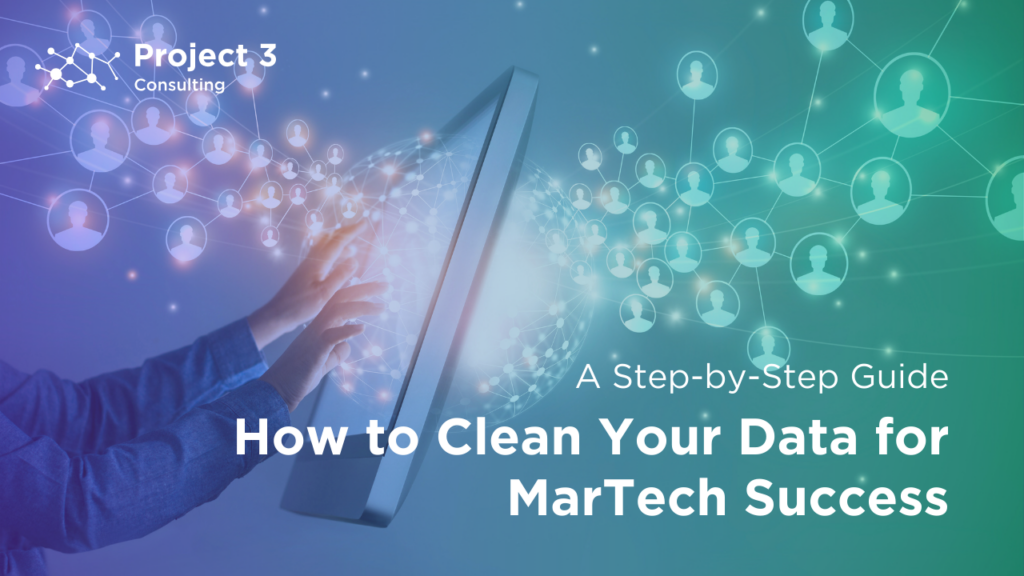
What good is data if you can’t trust it?
In every MarTech platform, one truth remains constant: the accuracy and cleanliness of your data are the foundation of every successful campaign. From understanding customer behavior to fine-tuning audience segments, clean data is a must for actionable insights. When data becomes messy, incomplete, or inaccurate, it can skew decision-making, leading to missed opportunities and wasted time and resources.
“People spend 60% to 80% of their time trying to find data. It’s a huge productivity loss.” This speaks to the operational inefficiencies caused by poor data management.”
– Dan Vesset, Group VP at IDC
In this blog, we’ll guide you through a step-by-step process for cleaning your data—whether you’re doing it for the first time or optimizing your existing workflows. Along the way, we’ll share industry insights and real-world examples to show why clean data is essential to any MarTech strategy.
1. Identify and Audit Your Data Sources Before the Clean
Before you can clean your data, you need to know where it’s coming from. Much like tracing a river upstream to find its source, understanding your data’s origins is essential. MarTech ecosystems often involve several tools, from CRMs and analytics platforms to tag managers and Customer Data Platforms (CDPs). If your data sources are messy, so will your insights be.
Steps to follow:
- List your data sources: The first step in cleaning your data is to map out all systems where your data resides. This includes the obvious platforms like Google Analytics or your CRM, but also extends to email tools, tag managers (such as Google Tag Manager or Tealium), and any CDPs you may use.
- Conduct a data audit: Once you’ve identified your data sources, the next step is to evaluate their quality. A comprehensive data audit helps you assess the completeness, accuracy, and relevance of the data being collected. Are you tracking the right events and metrics across all systems? Are you collecting the right attributes (e.g., customer demographics, interaction details, etc.)? The goal of the audit is to uncover gaps, redundancies, or inaccuracies in the data and ensure that every source is aligned with your business objectives.
In the case of one of our recent clients, we identified numerous issues during their Tealium CDP implementation. The data layer was full of outdated tags and redundant data points, which were preventing them from accurately tracking customer behavior. This audit was the first step in fixing their analytics strategy and moving toward cleaner, more actionable data.
If you’d like assistance with your data audit, don’t hesitate to reach out to us at Project 3 Consulting. We’re here to help ensure your data is accurate, actionable, and ready for success.

2. Standardize Your Data Collection Processes
It might seem obvious, but standardized processes are the glue that keeps your data consistent, accurate, and easy to manage. Without standardized inputs, your data will be fragmented, making it harder to draw meaningful insights. Consistency in data collection ensures that no matter what platform or tool you’re using, the information you capture will be comparable, easy to integrate, and valuable for analysis.
Steps to follow:
- Create a unified data schema: A data schema defines the structure of how data should be organized and entered across all platforms. Establishing standardized naming conventions for fields, event tracking, and data types ensures that the same data is consistently recorded in the same way. For example, if you’re collecting customer data across multiple systems (CRM, email marketing, analytics), using a uniform schema—such as always labeling customer status as “Prospect,” “Lead,” or “Customer”—helps prevent confusion and ensures that all data is categorized consistently.
- Enforce consistency: Tools like Google Tag Manager (GTM) or Tealium are designed to help ensure that your data collection is uniform across different platforms. By using a tag management system, you can ensure that the same events, such as form submissions or button clicks, are tracked with identical parameters (like category, action, label).
Standardization is especially important when integrating multiple platforms. For example, if you’re using Google Analytics and a CDP like Tealium, you want to ensure that the same event (like a button click) is tracked in exactly the same way across both platforms.
3. Clean and De-Duplicate Your Data
The next step is to eliminate redundancy and remove outdated data. This can be especially challenging when you’re dealing with large amounts of data collected over time, but it’s essential for maintaining data integrity.
Steps to follow:
- Remove duplicates: Check for duplicate entries, particularly in your CRM or email lists. Use tools like Salesforce’s data clean-up features or data integration platforms to help manage this.
- Delete outdated records: Remove or archive data that no longer serves a purpose. For example, if you’re collecting customer data from surveys, remove old or irrelevant survey responses that are no longer applicable.
Example: A major e-commerce client we worked with had over 100,000 duplicate records in their customer database. These duplicates skewed their customer segmentation and sent inaccurate reports to the marketing team. Once we de-duplicated the data, their segmentation became far more accurate, and their campaign targeting improved.

“Without clean data, or clean enough data, your data science is worthless.” – Michael Stonebraker, a prominent figure in the field of data science.
4. Validate and Enrich Your Data
Data validation ensures that the information you’re collecting is both accurate and relevant. Whether you’re gathering user input through forms, event tracking, or data feeds, you need to make sure that it’s clean, consistent, and valuable for decision-making.
Steps to follow:
- Implement validation checks: For web forms, use real-time validation to ensure that users provide accurate and complete data (e.g., email formats, required fields). For example, if you’re collecting email addresses, use regex (regular expressions) to check if the format is correct before the form is submitted. For address fields, make sure that ZIP codes or postal codes correspond with the correct region. Similarly, required fields should not be left blank, and you can provide instant feedback to users (e.g., “This field is required” or “Invalid email address format”).
- Enrich your data: Once your data is validated, the next step is to enhance it. Third-party data enrichment tools can provide additional context to your customer profiles, like demographics, interests, and online behavior, which can help you create more personalized marketing campaigns. You can use platforms like Clearbit or ZoomInfo to enrich contact details such as job titles, company names, social media profiles, or even purchase intent. This added information can help you better understand your customers and target them more effectively.
Recent News: Google’s Privacy Sandbox initiatives are reshaping how data is tracked and enriched, especially when it comes to third-party cookies. As third-party cookies phase out, marketers will need to rely more on clean, first-party data to enrich their user profiles and build more personalized experiences.
5. Ensure Compliance with Data Privacy Regulations
With laws like GDPR, CCPA, and the growing focus on privacy, it’s critical that your data handling practices comply with current regulations. Failing to comply can lead to hefty fines, reputational damage, and loss of customer trust. On the flip side, strong privacy practices can set you apart as a trustworthy brand that respects customer data.
“Organizations that embrace comprehensive data governance strategies achieve a 25% reduction in data inconsistencies, leading to significantly faster decision-making and improved operational outcomes.”
– Forrester, 2024
Steps to follow:
- Verify consent mechanisms: Ensure that your data collection methods have clear consent options for users.
- Respect opt-outs: Implement systems that immediately reflect user opt-out requests across your advertising, email, and analytics platforms. This helps maintain both compliance and customer trust.
- Stay updated on laws: Privacy regulations evolve frequently. Regularly review your policies to ensure they align with current standards, especially if your business operates across multiple regions.
Example: At Project 3 Consulting, we worked with a major American automotive company facing challenges with their consent platform. Their previous system wasn’t properly maintained, causing tags to fire even when users opted out—a potential violation of both GDPR and CCPA.
We stepped in to perform a detailed audit of their consent mechanisms, uncovering significant flaws in their data handling practices. After implementing Usercentrics, a robust CMP, we ensured compliance by enabling clear user choices and automated opt-out systems. Our ongoing maintenance of their platform not only protected them from legal risks but also reassured their customers that their privacy was taken seriously.
6. Automate Data Management
Manual data cleaning is time-consuming and prone to errors. Automation tools can help streamline data management and ensure continuous data hygiene.
Steps to follow:
- Leverage automation tools: Use tools like Zapier or custom API integrations to automate the transfer and clean-up of data between systems.
- Schedule regular audits: Set up periodic audits to check data integrity and make adjustments as needed.
Automation can be especially helpful for e-commerce businesses that collect large volumes of transaction data. By automating data imports and validation, businesses can save time and ensure their data remains accurate and up-to-date.
7. Collaborate Across Teams
Data doesn’t live in a vacuum—it’s used by marketing, sales, IT, and customer service teams. To keep data clean, it’s essential that everyone is on the same page.
Steps to follow:
- Align your teams: Ensure that all teams are following the same data processes and have a shared understanding of data governance. Use platforms like Slack or Microsoft Teams to centralize communication and share updates regarding changes to data processes or structures.
- Regular training: Provide ongoing training for staff to make sure everyone understands the importance of data cleanliness and their role in maintaining it.
- Document changes: Maintain a shared, easily accessible document or wiki (such as Confluence or Notion) to log all updates to data collection methods or processing workflows.
Example: At Project 3, we’ve found that collaboration between IT and marketing teams is crucial when building and maintaining the data layer for tools like Tealium and Google Analytics. By creating dedicated Slack channels for cross-functional projects and using real-time updates to notify teams of major changes, we’ve helped clients avoid inconsistent tracking and improve their overall data quality.
8. Monitor and Maintain Data Quality Over Time
Cleaning your data is not a one-off task—it’s an ongoing process that requires constant attention.
Steps to follow:
- Set up monitoring systems: Use data quality metrics and automated alerts to keep track of any issues as they arise, such as missing values, duplicate records, or outdated entries. Set up automated alerts through platforms like Looker or custom scripts to flag anomalies in real time.
- Establish a feedback loop: Have a process in place for teams to flag data issues, so they can be addressed quickly. For example, a shared Slack channel or a ticketing system like Jira can streamline issue reporting and resolution.
- Schedule periodic audits: Conduct regular audits into your MarTech tools (e.g., CRM, CDP, or tag managers) to ensure tracking remains accurate, schema changes are implemented consistently, and outdated data is cleaned out.
- Track the cost of poor data quality: Assign metrics like revenue impact or hours spent fixing issues to make the case for continuous data upkeep.
Regular monitoring of your data quality will help you stay ahead of issues and ensure that your MarTech systems are always working with the best data possible.
Conclusion
Clean data is the foundation of a successful MarTech strategy. It enables accurate decision-making, ensures compliance with privacy regulations, and sets the stage for business growth. While the process of cleaning your data may seem daunting, following these steps and leveraging the right tools will ensure your data supports your goals rather than hindering them.
“You can have all of the fancy tools, but if [your] data quality is not good, you’re nowhere.”
– Veda Bawo, Director of Data Governance at Raymond JameS
Once your data is clean, you can then shift your focus to what truly sets your business apart—like crafting personalized customer experiences, streamlining workflows, and building a competitive advantage that puts you ahead in the market.
Need help with your data audit or data management processes? Contact us at Project 3 Consulting, and let’s get your data in shape for long-term success.




